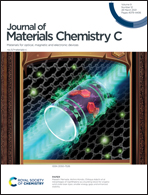Lead-free zero dimensional tellurium(iv) chloride-organic hybrid with strong room temperature emission as a luminescent material†
Abstract
Despite the current progress in ‘Pb-free’ low dimensional main group metal halide based luminescent materials, it is challenging to synthesize Te(IV) halide hybrids with strong ambient emission with excitation features in the visible range as efficient and stable phosphors for potential lighting applications. Reported here is a (benzyltriethylammonium)2TeCl6 zero dimensional hybrid material with excitation features in the visible range and strong room temperature, broadband, intrinsic luminescence (PLQY ∼15%) arising due to self-trapped excitons (STEs). Furthermore, a proof-of-concept LED architecture demonstrates successful optical down-conversion with a visible light excitation source. Here, exclusive adoption of a ‘regular’ octahedral Te(IV)-halide unit structure with minimal static distortion provides a unique opportunity to unmask the role played by 5s2 lone pair electrons in shaping the emissive properties. This effort may open up new avenues towards unravelling the role of lone pair stereoactivity in controlling the PLQY in low dimensional hybrids that has proven to be challenging for the reported (Sb, Sn) based low dimensional 5s2 metal halide hybrid materials.

- This article is part of the themed collection: Editor’s choice collection: luminescent metal halides


 Please wait while we load your content...
Please wait while we load your content...